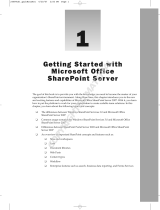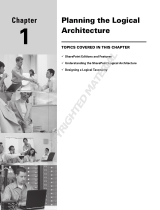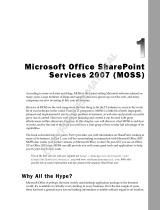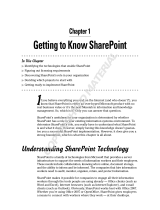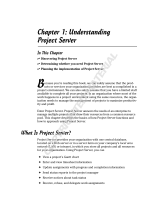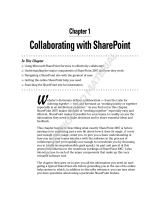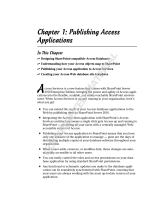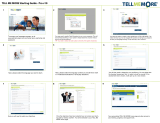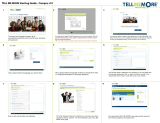Page is loading ...

Getting Started
with the Windows
SharePoint
Services 3.0 Platform
MICROSOFT EXAM OBJECTIVES COVERED
IN THIS CHAPTER:
Deploy Windows SharePoint Services 3.0 (WSS)
Configure WSS server roles
Configure WSS topology
Chapter
1
CH001.indd 1CH001.indd 1 9/1/09 7:06:11 PM9/1/09 7:06:11 PM
COPYRIGHTED MATERIAL

Since you are reading this chapter, it means you are committed
to learning how to use and administer Windows SharePoint
Services (WSS) 3.0. Perhaps this is your own personal com-
mitment to become familiar with a new technology that has become a leader in the fi eld of
collaboration. We hope this is so — but since we are also realists, we know you might be
here because you have been given another hat to wear in your organization. Don ’ t worry if
that describes you. Don ’ t worry if you are the network or SQL administrator and have now
been also charged with the SharePoint services for your organization.
And, also equally important, you are most likely here because this book will guide
you to gain the knowledge to pass the Microsoft 70 - 631 exam. Certifi cation credentials
show you understand and know how to use a product. This book is built around the exam
objectives; as you gain knowledge in those areas you need for implementing WSS 3.0, you
are provided with exam questions and key topics to augment your learning and studying.
If there is any one word of advice that we can give you as you proceed through this
book, it is to plan . All too often, we have worked with companies that have put up WSS
sites only to fi nd that their topology has gotten completely out of hand because users
became so enthusiastic that the sites and content grew too rapidly. “ Wow, how terrifi c! ”
you might be thinking. But a SharePoint implementation can become unwieldy and not
fulfi ll the objectives it was built to meet. Therefore, our purpose as we travel through this
book together is not only to provide you with the necessary tools to enable you to confi gure
your SharePoint site, but also to show you best practices along the way.
Before launching into the specifi c installation, confi guration, management, and
customization areas of WSS 3.0, you need to learn the building blocks. It ’ s part of our
“ strong foundation ” approach. To understand the design goals of WSS 3.0, you will begin
with an overview of the service. Your next step is to understand the technology. You will
learn those features that collaborate to make WSS 3.0. Once you understand what a WSS
3.0 solution is able to provide, you need to determine how it fi ts into your organization.
As in most of its applications and services, Microsoft provides the building blocks, but
you need to use them to design an implementation that serves your organization ’ s needs.
The last section of this chapter, and hence the last part of the WSS 3.0 foundation, is the
architecture. You need to grasp the logical architecture of a WSS 3.0 deployment so that
you can plan the physical structure accordingly. With all that said, let ’ s start building!
CH001.indd 2CH001.indd 2 9/1/09 7:06:13 PM9/1/09 7:06:13 PM

Overview of Windows
SharePoint Services 3.0
To understand WSS 3.0 is to understand collaboration. Originating from the Latin
com - ( “ with ” ) and laboro
( “ work ” ), collaboration is a great word and, better yet, a terrifi c
concept for businesses.
Wikipedia defi nes collaboration as a recursive process where two or more people
work together toward an intersection of common goals — for example, an intellectual
endeavor that is creative in nature — by sharing knowledge, learning, and building
consensus. It further mentions that collaboration can often provide better results through
decentralization and does not always require leadership. Thus, when using collaborative
technologies in business, the sum of the parts can be greater than the whole.
As web - based technologies expanded, the challenge to provide an environment for
creating easily used public workspaces and collaborative sharing became more apparent
to companies. The conventional method of sharing data and folders over the network no
longer provided the solution. Not only did users waste valuable time searching through the
fi le system for their needs, but administering security on the network fi le system became
paramount, with users needing a variety of access to fi les within the same folder. Another
collaborative technique used by many was to exchange data via email. Again security
became an issue. Archiving, storage limits, and diffi culty in maintaining audit history made
this technique fall short of organizations ’ collaborative needs.
It became apparent that minimizing data movement was the key to both stabilizing data
access and security. With this goal in mind, Microsoft conceived SharePoint Services.
The Evolution of Microsoft Windows SharePoint Services
Early concepts of Microsoft’s collaboration tool used Team Folders and the Digital
Dashboard to enable users to defi ne their own collaboration spaces. SharePoint Team
Services changed the one-way publishing paradigm of company intranets into an
organized and structured venue, thus allowing users to save and share their information
directly on the Web. The next iteration, Microsoft WSS 2.0, leveraged Windows
SharePoint Services and moved the storage of common data off the web server onto
the SQL Server. WSS 3.0 and Microsoft Offi ce SharePoint Server 2007, which is built
on the WSS 3.0 foundation, encompass the most recent version of this information
management software. They provide several communication tools to create a workspace
in which users can readily collaborate and communicate in a secure environment.
WSS 3.0 is designed to enable organizations to improve team productivity and increase
business process effi ciency.
Overview of Windows SharePoint Services 3.0
3
CH001.indd 3CH001.indd 3 9/1/09 7:06:13 PM9/1/09 7:06:13 PM

4
Chapter 1
Getting Started with the WSS 3.0 Platform
Let ’ s begin our journey by examining the components of WSS 3.0:
What is Microsoft WSS 3.0?
Why should we use WSS 3.0?
What are the new and enhanced features?
What Is Microsoft WSS 3.0?
Most likely you have been charged with either initiating or updating a SharePoint
infrastructure. Well, you will not get far in your endeavor if you do not understand WSS
3.0 and its role as the foundation for all the SharePoint technologies.
When we ask users to define WSS, they often tell us it is the “ free ” version
of SharePoint. Well, even though it is true that WSS is a free download
from Microsoft, it is more than that. All SharePoint technologies are built
on this service. Take Windows Workflow Foundation as one example; this
technology would not even exist were it not for the persistence service of
WSS 3.0.
The most important concept to grasp is that WSS 3.0 is built on Windows Server 2003
or Windows Server 2008 and provides the foundation platform and collaboration features
for Microsoft SharePoint products and technologies. The services provided by WSS are
shown enclosed in the dashed areas of Figure 1.1.
With that in mind, Microsoft built a set of design goals for WSS 3.0:
Storage
Security
Management
Deployment
Site Model
Extensibility
Collaboration
These goals have evolved into the platform services for WSS 3.0 and are discussed later
in this section.
CH001.indd 4CH001.indd 4 9/1/09 7:06:14 PM9/1/09 7:06:14 PM

As noted in Figure 1.1, Microsoft Offi ce SharePoint Server (MOSS) 2007 builds on the
technologies of WSS 3.0 to proide the following applications and services:
Portal Services MOSS 2007 portal technology allows you to create and manage gateways
to all the features and functionality of SharePoint technologies. It also provides users with
a greater personalization of their SharePoint experience.
Search You can use MOSS 2007 ’ s Search feature to query documents, people, and
enterprise applications.
Enterprise Content Management Enterprise content management in MOSS 2007
includes document, records, and web content management. These services include full web
publishing; enterprise - wide documents and records retention, which includes auditing and
security compliance; and approval workfl ows.
Business Processes Workfl ow, one of the business processes of MOSS 2007, facilitates
collaboration among users for such processes as document approval, feedback collection
FIGURE 1.1 Windows SharePoint Services 3.0, architectural view
Windows 2003 or 2008 Server Operating System
.NET 3.0 Framework
.NET 3.0 Framework
Database Services
Database Services
Internet Information Services
Internet Information Services
Collaboration
Collaboration
Portal
Services
Enterprise
Content
Management
Search and
Indexing
Business
Intelligence
And
Forms
Management
Shared Services
Workflow
Workflow
Search
Search
Network
Network
Windows SharePoint Service 3.0 Foundation Services
Security
Security
Site Model
Site Model
Extens ibility
Extens ibility
Deployment
Deployment
Storage
Storage
Architectural View
Management
Man ag em en t
Operating System Services
Overview of Windows SharePoint Services 3.0
5
CH001.indd 5CH001.indd 5 9/1/09 7:06:15 PM9/1/09 7:06:15 PM

6
Chapter 1
Getting Started with the WSS 3.0 Platform
for document review, and disposition approval for archiving information. The InfoPath
forms service assists in collecting and validating business process information.
Business Intelligence You are able to integrate your line - of - business (LOB) application by
using the Business Data Catalog (BDC) in MOSS 2007. Furthermore, Business Intelligence
(BI) employs Excel Calculation Services to manage and share Offi ce Excel 2007 workbooks
and reports, integrates with SQL Reporting Services, and includes key performance
indicators (KPIs) to track the progress of your business goals.
The term “ SharePoint Technologies ” is used throughout this book to
encompass both WSS 3.0 and Office SharePoint Server 2007 products and
services.
In the architectural view of WSS 3.0, each layer provides the necessary services that
are consumed by the layers above them. Therefore, to understand the topology it makes
sense for us to study these layers starting with the foundation layer of the operating system
service and working our way up.
The Operating System Services
The foundation layer is the operating system services. WSS 3.0 is built on these
technologies and services, which were introduced in Windows Server 2003 and extended
in Windows Server 2008. You can install WSS 3.0 on the Standard, Enterprise, or Web
edition of Windows Server. As a best practice, have the service packs and patches up - to -
date on your server.
If you install WSS 3.0 on Windows Server Web edition, you must use a
remote SQL Server to store the WSS databases.
Windows Server provides the system and networking services to all the upper layers of
the SharePoint technologies. The internal relational database that is the data store within
Windows Server itself provides the repository for Windows roles and features as well as
such services as Active Directory Rights Management Services, UDDI Services, Windows
Update Services, and Windows SharePoint Services.
Microsoft SQL Server provides the data repository. Although WSS 3.0 was built to
perform with SQL Server 2005, you can also use SQL Server 2008 or the previous version
of SQL Server 2000 as your database solution. WSS 3.0 uses the relational database
technology of SQL Server to store all confi guration, data, and content information.
Windows Server also provides the core and development platform services for WSS 3.0.
These include:
Windows services consumed by WSS 3.0, including the NTFS file system
Microsoft Internet Explorer 6.0 or Internet Explorer 7.0
Microsoft .NET Framework 3.0, which includes:
CH001.indd 6CH001.indd 6 9/1/09 7:06:16 PM9/1/09 7:06:16 PM

ASP.NET 2.0 master pages, web parts, and content pages as well as its pluggable
service provider models
Microsoft Windows Workflow Foundation (WF), which employs WSS 3.0 as the
workflow host for developing routing, approval, and other custom workflows to
model business processes
Internet Information Services (IIS) 6.0
WSS 3.0 uses IIS websites to host web applications. Keep the following in mind:
A web application is an IIS website that is created and used by SharePoint
technologies. Each WSS 3.0 web application has its own website in IIS.
You must configure the computer to be a web server by enabling IIS 6.0, including
common files, World Wide Web publishing service (WWW), and Simple Mail Transfer
Protocol (SMTP). IIS is not enabled by default on a Windows server.
You must also configure the server to use IIS 6.0 Worker Process Isolation Mode. This
is the default setting in new installations.
If you are using Windows Server 2000 and have upgraded from IIS 5.0, the
setting Run WWW in IIS 5.0 Isolation Mode is enabled. Since each worker
process must be isolated for your WSS 3.0 implementation, you must
change the IIS setting to IIS 6.0 Worker Process Isolation Mode.
To enable email notifications, you need to configure incoming and outgoing
email settings.
To configure sending email alerts and notifications, you must specify an SMTP
email server.
To configure your installation so that your SharePoint sites can accept and archive
incoming email, you must install the IIS SMTP service.
WSS 3.0 Platform Services
Microsoft ’ s design goals evolved into the platform services of WSS 3.0. The WSS 3.0
Platform Services include the following:
Storage
Organizations need a central repository to store a variety of information and its
metadata.
WSS 3.0 provides lists, libraries, pages, and sites as containers for storage.
Overview of Windows SharePoint Services 3.0
7
CH001.indd 7CH001.indd 7 9/1/09 7:06:17 PM9/1/09 7:06:17 PM

8
Chapter 1
Getting Started with the WSS 3.0 Platform
Security
Authorization and authentication must be maintained. Users, whether a part of
the organization environment or a public interface, need to be granted security -
trimmed access - level permissions.
WSS 3.0 supports pluggable authentication and a rights - trimmed user interface.
Management
Organizations need to be able to monitor and manage information from a central-
ized location.
WSS 3.0 provides a Central Administration site for managing information and
provisioning of administrative tasks.
Deployment
Organizations need both intranet and extranet deployment strategies. Organiza-
tions need to be able to upgrade from WSS 2.0.
WSS 3.0 provides in - place and gradual upgrade procedures. It also supports
extranet deployments.
Site Model
Users need to have a consistent experience through uniform navigation and site
templates.
WSS 3.0 allows sites to be developed on site templates and provides both global
and current navigation features.
Extensibility
Organizations require web services support and the ability to create custom
applications.
WSS 3.0 provides for a variety of external connectivity, such as forms based
authentication, and enables you to create custom applications by using object
model enhancements.
WSS 3.0 Collaboration Service
Organizations require collaboration for their users to stay connected and be productive.
WSS 3.0 provides out - of - the - box (OOB) collaboration features to enable your
organization ’ s employees, business partners, and customers to share information such as
documents and events and to work together in a friendly environment.
Here are the collaboration features WSS 3.0 provides:
Online Presence Online presence offers synchronous communication among your team
members. User status is extracted and integrated into WSS through Microsoft Active
Directory, Microsoft Exchange, and Windows Messenger. Presence can be discovered by
using web parts that enable your team to see if their coworkers are available for real - time
conferencing or message exchanging.
CH001.indd 8CH001.indd 8 9/1/09 7:06:18 PM9/1/09 7:06:18 PM

Team Sites Team sites provide a central portal for information worker resources. They
provide a home page and OOB lists and libraries for collaboration, such as Announcements
and Calendar lists and a Shared Documents library. You have other list and page templates
available for a variety of your collaboration needs.
Meeting Workspaces Meeting workspaces are team sites that enable you to plan,
organize, and track your meetings. They provide a home page with lists for you to include
information about your meetings, such as objectives, agendas, attendees, tasks, and
decisions.
Wikis Wikis are open sites where your users can freely create and edit content. Its value
stems from the collaborative authoring of your users. Your team can share information
readily using wikis.
Blogs Blogs are online journals. The name is taken from “ web logs. ” The blog is owned
and maintained by its author, the blogger, who uses the area to document information of
interest. Readers can post comments on the site in reference to the blog. A blog site can also
be used by your team members to disseminate and share information.
Web Parts You can think of a web part as a single - purpose, modular unit of information
on a page. Web parts themselves are software components that are customizable through a
tool pane when placed into a web part zone on your page. WSS 3.0 has many built - in web
parts; however, you can also import or add web parts from other reliable sources into your
WSS environment.
Discussion Boards Discussion boards provide a conversation mechanism for your team
members. Many features are built into the boards to supply security for approval of entries
as well as the control needed to manage the discussion threads.
Issue Tracking Issue tracking helps your team maintain and manage issues and problems
throughout the enterprise. It allows you to assign, prioritize, and follow the complete
progress of your issues.
Contact Lists Contact lists enable your team members to create the details of information
for others they work with. Contact lists facilitate communication by keeping information
available in a single location.
Integration Features WSS 3.0 supports close integration with all Microsoft Offi ce
products, most particularly the Offi ce 2007 line of products. Furthermore, WSS integrates
with Microsoft Offi ce SharePoint Designer 2007 for customizing your sites, with Microsoft
Exchange for providing mail service, and with Active Directory and Information Rights
Management for security. You can also provide secure offl ine data access through a variety
of connection services.
Why Use WSS 3.0?
As you consider a collaboration solution for your organization, you should also consider
what that solution will provide to be effective. If you build it, they will not always come.
A successful solution requires the synergy of the users to be a part of its implementation,
Overview of Windows SharePoint Services 3.0
9
CH001.indd 9CH001.indd 9 9/1/09 7:06:18 PM9/1/09 7:06:18 PM

10
Chapter 1
Getting Started with the WSS 3.0 Platform
support, and use. Furthermore, it requires keeping the total cost of ownership (TCO) as
low as possible.
Let ’ s take a quick look at some reasons solutions fail, just to make certain you cover all
bases in your implementation of WSS 3.0:
No Governance We have seen a large number of implementations fail because a
governance plan was not put into place. Governance defi nes WSS 3.0 as a service with a
plan describing service - level agreements (SLAs), adoption policies, usage, and support.
Lack of Security Quite often an organization is seeking a solution deployment that will be
used both internally and externally. Often solutions do not provide an easy mechanism for
external security.
Inability to Integrate Custom Applications Most organizations require several specialized
line of business (LOB) applications. If there is no easy way for users to implement these
systems with one another, they will lose not only time but also data consistency with data
transfer.
Expense Custom applications and solutions that are written in - house are expensive
to create and maintain. You need a group of developers always available for changes,
maintenance, and updates.
Difficulty of Use Well, this is a no - brainer. The solution might be terrifi c, but if your
team members don ’ t think it is intuitive to use, it will be ineffective.
High Training Costs To keep down the cost of training, organizations often resort to
training small groups of users and expect them to transfer knowledge to the remainder of
the team. This process often leaves gaps in knowledge transfer, consequently leading to
users being slow or even adverse to adopting the new solution.
Lack of Ownership If your users do not see a personal business benefi t, even if all other
needs are met, they will be slow to use it. If your users feel that someone has pushed the
solution on them, it decreases their desire to use it. You need to fi nd a way to create the
synergy we mentioned earlier. Users should be involved in both creating and maintaining
the solution.
Top 10 Benefi ts of WSS 3.0
So, just what does WSS 3.0 bring to the table with regard to providing a robust, easy-
to-use, and defi nitive solution? The Microsoft SharePoint team provides us with the
following top 10 benefi ts of WSS 3.0:
1. Improve productivity with ease-of-use collaborative tools. Your users can connect
easily and readily with the collaborative tools WSS 3.0 provides. Your team can create
workspaces, blogs, and wikis for customized information sharing. In addition, your
CH001.indd 10CH001.indd 10 9/1/09 7:06:19 PM9/1/09 7:06:19 PM

mobile users can take SharePoint with them by using WSS 3.0’s offl ine synchronization
capabilities.
2. Manage documents easily and securely. Your team can build on the capabilities of
WSS 3.0 to provide a secure repository using your document management requirements.
You can check out documents prior to editing, view and retain revisions, as well as
control security at the item level, and these are just a few of the included features that are
readily available.
3. Get your team on board quickly. WSS 3.0 integrates readily and provides navigation
and tool panes similar to other products in the Microsoft Offi ce suite. Its familiar interface
makes it easy for users to get up to speed quickly. The integration of WSS 3.0 with the
Offi ce products enables your team to easily work within either venue for their information
handling. As an example, your team can create workspaces, create and edit documents,
as well as view and update calendars on WSS 3.0 sites while working in their Microsoft
Offi ce programs.
4. Deploy business process solutions quickly. Your team can use the application
templates WSS 3.0 provides to quickly get started with business tasks. Further
customization can be accomplished by using development tools specifi cally designed for
WSS 3.0, such as Microsoft Offi ce SharePoint Designer 2007.
5. Establish a collaboration environment quickly. WSS 3.0 is scalable and easy
to administer. With proper planning, your organization can begin using WSS 3.0 on
a small-scale, single-server deployment and branch out to a more robust enterprise
confi guration. Your organization can change many deployment settings as well as
add new features after initial deployment. This enables you to start your collaboration
environment more rapidly.
6. Secure your business information. WSS 3.0 has controls for life-cycle management
of your business information. The central administration feature for your farm enables
your administrators to secure resources and membership permissions.
7. Control your company resources. You can decide who handles your WSS 3.0 site
resources. Your SharePoint administrators can set top-down policies for administering
users and groups as well as content recovery. Teams can set permissions at the
document or item level and also initiate self-service collaborative workspaces.
8. Enable robust storage capabilities. The compliant document storage and retrieval
functionalities of sites and workspaces rival third-party document storage applications
without the extra tedium of learning a new application. Along with the check-in/check-out
functionality and versioning mentioned earlier, your team is able to access information
using customizable views and specially created metadata.
Overview of Windows SharePoint Services 3.0
11
CH001.indd 11CH001.indd 11 9/1/09 7:06:19 PM9/1/09 7:06:19 PM

12
Chapter 1
Getting Started with the WSS 3.0 Platform
Understanding the Technology
Features of WSS 3.0
WSS 3.0 has many new features and enhancements to help you deploy and maintain your
SharePoint solution. You now have a multi - tier administration model so that you can
delegate your administrative responsibilities. You can take advantage of new and enhanced
compliance features to manage your business critical data. You have at your disposal
improved operational tools that enable you to maintain reliability and availability of
your information. Furthermore, you have the ability to add users from other data sources
outside Active Directory.
Let ’ s take a closer look at these enhanced technology features, which include
enhancements to:
Administration model
Compliance features
Operational tools and capabilities
Network support
Extensibility
Administration Model Enhancements
WSS 3.0 includes several enhancements to the administration model. Included is a new
model for centralized management and confi guration. This model enables you to manage
and administer your tasks more effi ciently.
9. Customize the solution to fi t your business needs. You can easily customize
your environment through the web browser or command-line utilities. For further
customization and branding, you can use Microsoft Offi ce SharePoint Designer 2007 or
Microsoft .NET Framework 3.0 utilities and applications.
10. Build web-based applications cost effectively. WSS 3.0 is a part of the .NET
Framework family. You can use these common resources to fi ne-tune your websites to
meet the specifi c needs of your organization.
CH001.indd 12CH001.indd 12 9/1/09 7:06:20 PM9/1/09 7:06:20 PM

Centralized Configuration and Management
The administration model includes a centralized confi guration database to synchronize
management and confi guration settings for all the servers in your WSS 3.0 farm. You no
longer need to manage your server farm confi gurations on a server - by - server basis.
A server farm is a collection of logical servers grouped together to
accomplish server needs that exceed the capabilities that one machine can
provide.
Two new services, the Windows SharePoint Services Administration service and
the Windows SharePoint Services Timer service, are responsible for facilitating this
centralized confi guration model. You can think of the Windows SharePoint Services Timer
service as the heartbeat for the server farm. This service runs timer jobs that propagate
the confi guration settings across the farm. You use the Windows SharePoint Services
Administration service to carry out the actual confi guration changes. The two services
work together to complete your administrative tasks effectively and effi ciently.
Two - Tier Administration Model
A two - tier administration model enables you to separate administrative responsibilities:
Tier 1: Farm Administrator Tier 1 management encompasses the central management of
the entire server farm. As a Tier 1 administrator, usually a member of your company ’ s IT
department, you perform the management of your farm - level resources.
Tier 2: Site Administrator or Site Owner Tier 2 management includes the management of
sites within the farm. As a Tier 2 administrator you perform the management of resources
at the site level. This management tier is typically performed by a business unit site
administrator who is not necessarily a member of the IT department.
This multi - tier model allows a delineation and separation of administrative
responsibilities. This delegation of responsibilities enables IT professional to concentrate on
IT roles, leaving the management of individual site resources to those business professionals
most in touch with their needs and information.
Farm - Based Central Administration User Interface
WSS 3.0 provides a redesigned central administration site. As a farm administrator, you
can access key tasks readily from the interface. The Central Administration home page
provides easy navigation to the Operations and Application Management pages. On the
Operations page, you are provided with links to manage entities such as farm - wide services
as global confi gurations, security confi gurations, backup and restore settings, and logging
and reporting.
Understanding the Technology Features of WSS 3.0
13
CH001.indd 13CH001.indd 13 9/1/09 7:06:21 PM9/1/09 7:06:21 PM

14
Chapter 1
Getting Started with the WSS 3.0 Platform
Compliance Features Enhancements
WSS 3.0 offers features to control your information resources more effi ciently:
Policy Management You can defi ne policy management that is based on your
authentication provider. You can use authentication zones to control group and user access
control lists (ACLs). Furthermore, access control is now taken all the way down to the
item level.
Auditing and Logging WSS 3.0 allows you to confi gure auditing and logging for all
actions on your sites, on the content within your sites, and on all workfl ow processes.
Security Trimming WSS 3.0 is security trimmed. Users are allowed to see only that
information for which they have permissions. For example, an IT administrator cannot
view site content on WSS sites unless he is granted site collection administration privileges.
Furthermore, if an IT administrator changes site collection administrator privileges, an
event is written to the Event Viewer application log.
Operational Tools and Capabilities Enhancements
WSS 3.0 provides several new and enhanced tools to assist you in your operations of your
SharePoint environment. Here are a few:
Multistage Recycle Bin The multistage Recycle Bin enables users to retrieve deleted items
without WSS administrator intervention.
Volume Shadow Copy Service WSS 3.0 has an enhanced backup and restore capability
that supports Volume Shadow Copy Service.
Gradual Upgrade Gradual upgrade provisions have been created so you are able to
upgrade from WSS 2.0 without interrupting your business processes.
Reparenting You can also reparent in WSS 3.0; that is, you are able to change the
structure of your WSS site hierarchy.
Managing Service Accounts SharePoint Central Administration enables you to manage all
your service account credentials.
Stsadm Command - Line Tool The command - line tool
Stsadm.exe has enhanced
capabilities. For example, you are able to rename your web servers and back - end database
servers.
Network Support Enhancements
WSS 3.0 has enhanced support for your network confi gurations, including:
Alternate Access Mappings Alternate access mappings in WSS 3.0 provide the mechanism
for adding and handling new front - end web servers to your web application. For example,
if your initial installation of WSS 3.0 is on a single front - end server, your users just browse
CH001.indd 14CH001.indd 14 9/1/09 7:06:21 PM9/1/09 7:06:21 PM

to your server, which renders the content they need. If you add an additional server, users
will not be able to access the content of this server through the web application until you
add it to the alternate access mapping.
Pluggable Authentication You can use non - Windows - based authentication providers
to access WSS 3.0. Your users can be a member of identity databases other than Active
Directory. The pluggable authentication of the Microsoft ASP.NET forms authentication
system is now integrated into WSS 3.0. Any data storage can be used as a membership
provider, such as a SQL database or even a list on your WSS site.
Extensibility Enhancements
WSS 3.0 has several extensibility enhancements you can use on your sites to improve their
functionality or to customize them.
Creating and Deploying Features
Feature creation and deployment allow you to immediately add functionality to your
sites. You can create new or build on existing site defi nitions by employing Features .
Your developers build Features using Visual Studio; however, WSS 3.0 administrators
deploy the Feature solution through the Stsadm command - line tool or SharePoint Central
Administration.
Creating Custom Applications
By using Microsoft Offi ce SharePoint Designer 2007 or Visual Studio, you can extend WSS
3.0 by creating custom applications. The signifi cance of using WSS 3.0 is that it not only
provides the interface to the application data through web services, but also provides the
capability of creating the custom page the user will access to interface with the application.
Hosting Workflows
WSS 3.0 provides the hosting for Windows Workfl ow Foundation (WF). As part of the
.NET Framework, WF has no executables and is dependent on WSS 3.0 to execute the
persistence, transaction, scheduling, and tracking services it requires.
Planning, Planning, and Planning
a WSS 3.0 Solution
Did we mention you should plan? As you have learned, for your implementation to be
effective, it must embody the synergy of the users who implement, support, maintain, and
use it. We love that word to describe WSS 3.0, since synergy describes a situation where the
Planning, Planning, and Planning a WSS 3.0 Solution
15
CH001.indd 15CH001.indd 15 9/1/09 7:06:22 PM9/1/09 7:06:22 PM

16
Chapter 1
Getting Started with the WSS 3.0 Platform
outcome is greater than the sum of its parts. So, your objective in planning is to make your
WSS 3.0 solution a truly synergistic collaboration.
As you plan, you need to refl ect once more on the design goals of WSS 3.0. Which goals,
and hence which services, pervade and provide for your users ’ needs?
There are several factors you should consider in planning your solution:
Determining the purpose of your solution
Determining the needs of your users
Determining the number and types of users
Determining the Purpose of the Solution
Each WSS 3.0 site you create provides its own set of blocks: home page, lists, libraries,
and security implementation. Before you can start putting the blocks in place, you need
to identify your users ’ vision of this workspace. You must identify what you want to
accomplish with the structure. Once you have the objectives in place, you must determine
the primary environments you can use to meet them.
Determining the Objectives
We have already mentioned the word plan, but now we ’ re giving you one further piece of
advice: listen.
Involving Stakeholders
One of the most successful implementations we were involved with had to do more with
talking and listening than with planning; the planning evolved readily from the listening.
As we were in the process of looking for a better solution, we interviewed stakeholders
at all levels. Also, we met those stakeholders in their own environments; we went to
their workspaces so they could show us their needs and ideas to make their jobs more
productive and at the same time easier. We found the most important concepts that
we were able to build on came from those stakeholders who had direct contact with
the everyday data. When we reconvened from our interviews with our fi ndings, the
objectives and needs of our solution were easily identifi ed. Once we built our concept of
those fi ndings, we took our prototype to the stakeholders. Once again we listened and
took appropriate action with the design. By time we rolled out the initial phase of our
implementation, our stakeholders were anxious to be trained and use the solution. They
saw their ideas in action; they felt ownership.
CH001.indd 16CH001.indd 16 9/1/09 7:06:22 PM9/1/09 7:06:22 PM

Your WSS 3.0 environment is very fl exible. However, you need to focus on some
primary objectives for your sites. The design of a site needs to refl ect its purpose.
For example:
Will the site be used for team collaboration? Is it a place to share ideas?
Will the site be used as a document repository? Do document management features
need to be in place?
Will the site be used for reporting? How do you connect WSS 3.0 to the back end data?
Will the site be used for communication? Will users be accessing announcements or
forms? Will the site display events through a calendar interface?
If you are nodding your head or answering yes to several of these questions, you should
think about creating multiple sites. Remember, you want them to come. And once they are
there, you need to remind them why they came.
So, here is the short list of objectives for WSS 3.0 sites:
Collaboration
Document storage
Information reporting
Communication
If you fi nd yourself in the predicament of only having one site but with multiple
objectives, you need to be very precise in organizing your home page so users are able to
identify the purpose of coming immediately.
Identifying the Primary Environments
WSS 3.0 can live in several environments. To effectively plan your sites, you need to
identify the environment(s) in which it will live.
Typically companies create intranet sites and use them for collaboration.
However, you have seen that WSS 3.0 has so many features to offer; it
is time to start thinking outside of the box. Don ’ t forget to listen to those
stakeholders.
Here are the primary environments for WSS 3.0:
Intranet An intranet site most often includes user contribution. Some users will interact
with the site ’ s structure, others will contribute to the site ’ s content, and others will merely
view the site.
Extranet An extranet could be nothing more than allowing out - of - the - offi ce access to
your intranet site for your authenticated intranet users. On the other hand, an extranet
environment could be strictly conceived for only external users and serve such purposes
as sharing necessary information with other partners on a common project. For either
Planning, Planning, and Planning a WSS 3.0 Solution
17
CH001.indd 17CH001.indd 17 9/1/09 7:06:23 PM9/1/09 7:06:23 PM

18
Chapter 1
Getting Started with the WSS 3.0 Platform
of these scenarios, you need to determine the authentication (who has access) and their
authorization (what they are allowed to access) from the extranet zone.
Internet An Internet solution has yet another set of security objectives. If you are
providing a service or promoting your company, you typically do not want to restrict access
to your site for viewing. However, you want to tightly control who can add content to the
site. Often an Internet site is used for ordering or collecting feedback from its users; that
is, you want the users to register and later sign in to have access to the content of your site.
For this scenario, you need to create a means of authenticating to the site and storing that
authentication.
Zones represent different logical paths of authentication to the same web
application. You can create up to five zones for each web application:
Default, Intranet, Extranet, Internet, or Custom. You use zones to enforce
sets of access policies for different classes of users.
Determining User Needs
Once you have delineated the objectives for your WSS 3.0 solution and sites, you need to
defi ne any further user needs and special requirements. You can then decide what features
to implement to support these needs.
Identifying Your Users ’ Needs Your users might have needs that should be addressed at
the time of planning.
Here is a sample list of some user needs that would need special considerations:
Connecting with back - end systems
Using the WSS 3.0 site while traveling or working offline
Receiving information regarding changes to the site
Sending email to the site
Using wiki or blog sites
Identifying Special Considerations You need to identify any necessary requirements that
evolve from the environments being used.
Here are some areas that require special considerations while planning your solution:
Determine if your solution requires integration with LOB applications.
Identify the client applications in your organization that will be interacting with
WSS 3.0.
Determine the servers in your organization that will be interacting with WSS 3.0.
Identify whether custom applications need to be interfaced with your solution.
CH001.indd 18CH001.indd 18 9/1/09 7:06:24 PM9/1/09 7:06:24 PM

Determine if there are additional feature requirements that need to be deployed or
added to the original definition of the site.
If your WSS 3.0 solution is part of a hosting company, determine the additional
applications, such as billing or auditing, that must interface with your solution.
Determining Which Features to Use Once the needs and considerations have been
recognized, you need to determine what WSS 3.0 features map to them. This step is
important because you need to determine any special requirements that you need to have in
place so that you can implement the feature.
Tables 1.1 through 1.5 list some of the most prevalent WSS 3.0 features.
TABLE 1.1 Communication Features
Feature Description Special Planning Considerations
Announcements Share news and information
Shared Calendar Schedule and share events
Links Share data in other locations
through links
Email Send information to a list Requires an SMTP mail server
Survey Collect data from users
Presence Determine who is online Requires a client application to process
presence information — for example,
Windows Messenger
TABLE 1.2 Collaboration Features
Feature Description
Discussion board Share ideas and discuss
Issue Tracking Track issues
Contacts Store contact information
Planning, Planning, and Planning a WSS 3.0 Solution
19
CH001.indd 19CH001.indd 19 9/1/09 7:06:25 PM9/1/09 7:06:25 PM

20
Chapter 1
Getting Started with the WSS 3.0 Platform
TABLE 1.3 Document Storage and Workflow Features
Feature Description Special Planning Considerations
Document library Store, share, present, and track
documents
Need to plan for supported
content types and metadata
Picture library Store and share pictures
Tasks Assign and track tasks
Recycle Bin Recover deleted items, documents,
and lists
Need to determine Recycle Bin
configurations
TABLE 1.4 Information Management Features
Feature Description Special Planning Considerations
Alert Track changes to documents,
items, lists, libraries, or the
entire site
RSS feed Subscribe to a site to be
informed of what is new or
changed
Requires RSS client application
Auditing Flag what is happening on
the site
Determine if you want specific
auditing reports
Offline Take documents or lists offline to
continue working
Requires the necessary client
application
Mobile Access the site from mobile
devices
Data connection Access data from other systems
and use web parts to display
content
Search Find information within a specific
site, list, or document library, or
across all sites in a site collection
Determine search scopes
CH001.indd 20CH001.indd 20 9/1/09 7:06:25 PM9/1/09 7:06:25 PM
/
